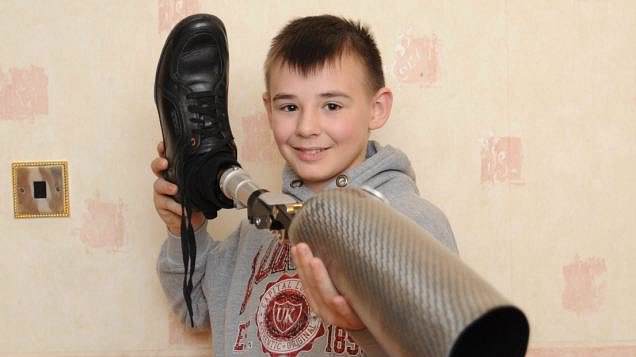Brits were today urged to watch out for frequently forgotten signs of one of the deadliest childhood cancers.
Awareness of symptoms of bone cancer in kids and young people is dangerously low across the country, a coalition of scientists and medics warned.
This is despite early diagnosis being key for the best chance of survival.
There are an estimated 150 new cases diagnosed in children in the UK every year, they said.
But long-term survival rates have remained unchanged for over 15 years, with fewer than seven in 10 patients on average surviving beyond five years.
Three quarters of bone cancers in the UK are initially misdiagnosed, with patients visiting health professionals eight times on average before even being referred, surveys show.
Research published today by the University of Nottingham analysed the symptoms suffered by over 1,400 young patients and pinpointed the most common signs of the disease — many of which can mimic common ailments.
Pain and swelling were the two most frequently reported, accounting for 64 and 22 per cent of all signs respectively.
This was followed by a fever (3 per cent), pain and swelling (3 per cent), pathological fracture (2 per cent) — a broken bone that occurs when the disease weakens the bone structure — and a palpable mass (2 per cent).
NHS GP Dr Anita Chithiramohan said: ‘Childhood bone tumours can be challenging to diagnose because the symptoms are often non-specific and may overlap with those of more common conditions, such as injuries or infections.
‘These challenges highlight the need to raise awareness of childhood bone tumours among healthcare professionals to facilitate earlier recognition and diagnosis.’
In the research, scientists analysed 16 studies involving 1452 patients under 18 — 492 with osteosarcoma.
Just half of all patients survive this bone cancer after their diagnosis, figures suggest. Often they are first diagnosed when a bone breaks.
The other 932 had been diagnosed with Ewing’s sarcoma — which records a slightly higher five year survival rate of still just two thirds.
In total, 36 different signs and symptoms were reported.
Others included having functional limitation — meaning children could not complete an activity normally — a limp and volume increase, when there is more fluid volume in the body.
But the researchers also noted that those with Ewing sarcoma were more likely to experience fevers, masses or impaired limb use than osteosarcoma patients.
Those with osteosarcoma, meanwhile, reported unexplained fractures, pain, and weight loss, more frequently.
Writing in the journal Archives of Disease in Childhood, the scientists also warned that despite bone cancer being one of the ten most common types of childhood cancer, young people and their families often don’t consider bone cancer a risk.
Around one in 10 patients wait over three months after noticing symptoms before talking to a healthcare professional.
Then they often face further delays before a diagnosis is reached.
Kieran Maxwell, from Darlington, was diagnosed with Ewing sarcoma in 2010 at the age of just 12.
Yet it took 14 months before he received confirmation.
After visiting his GP because his leg had become swollen and sore he was given antibiotics. It was only after the swelling failed to subside that he was eventually referred for an X-ray.
Told his tumour was located only in his left tibia — the shin bone — he underwent intensive chemotherapy and had his left leg amputated in 2011 before he was told he was cancer free.
But Kieran — who competed as an athlete internationally and carried the 2012 Olympic torch — died in 2017 aged just 18.
He had suffered multiple relapses between 2011 and 2017, with the cancer spreading to around his heart and lung.
His mum Nicola said: ‘Kieran’s diagnosis should have been quicker. We thought we were lucky as it hadn’t spread at initial diagnosis, but Kieran’s tumour kept coming back.
‘His first relapse was to his lungs, and the second relapse was to his heart.
‘It is very difficult to treat relapsed bone cancers and survival is very poor.
‘Early diagnosis has a positive impact on survival and the chance of recurrence drops quite significantly.
‘I often wonder, if Kieran had been diagnosed earlier, would we have had the chance to save his leg and his life?’
Ashley Ball-Gamble, CEO of Children’s Cancer and Leukaemia Group and study co-author said: ‘By identifying common symptoms, and showing differences between Ewing sarcoma and osteosarcoma, we are taking an important step toward improving awareness and reducing delays in diagnosis.
‘Raising bone cancer awareness in healthcare professionals is essential to ensuring that no child or young person’s symptoms are overlooked, and that treatment can begin as early as possible.
‘By acting on these findings, we can give every patient the best chance of survival.’
David Walker, emeritus professor of paediatric oncology at the University of Nottingham and study co-author, also added: ‘Efforts to improve outcomes for children with bone tumours have not led to improvements in cure rates or disability rates for nearly two decades.
‘It is time to look at whether accelerating diagnosis could change this static state of affairs.’
Osteosarcoma is a type of bone cancer. It is more common in older children over five and in teenagers.
The cancer often starts at the end of long bones, where new tissue forms as the bone grows.
The most common sites for the tumour to grow are in the arms and legs, particularly around the knee and shoulder joints.
What are the symptoms?
How is it treated?
Source: NHS
